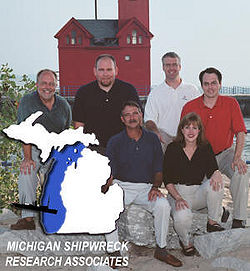Michigan Shipwreck Research Associates
MSRA is a 501(c)(3) non-profit corporation based in Holland, Michigan. Their stated purpose is to “Preserve Michigan’s Submerged Maritime History.”
Michigan Shipwreck Research Associates[1] was formed in 2001 by the former directors of the committee which established the Southwest Michigan Underwater Preserve. With the discovery of the steamer H. C. Akeley outside the boundaries of the preserve, the group broadened the area of focus and formed MSRA.
Current board members include: Craig Rich, Valerie van Heest, Ross Richardson, Jack van Heest and Geoffrey Reynolds.
MSRA works with a number of affiliates including the National Oceanic and Atmospheric Administration, Great Lakes Environmental Research Laboratory, the United States Coast Guard, the University of Michigan, and Michigan State Police.
Other affiliates include authors, archeologists, oceanographers, marine engineers, historians and explorers. MSRA has conducted joint operations with David Trotter's Undersea Research Associates (URA) and Clive Cussler's National Underwater and Marine Agency (NUMA).
Until 1998, the waters off the coast of West Michigan were some of the least explored in the Great Lakes. While they may have been surveyed, those conducting the exploration were unwilling to share their discoveries with the public. Rumors abound of shipwreck discoveries in the 1960s and 1970s.
In 2000, there existed only a handful of discovered and documented shipwrecks in the water off the southwest coast of Michigan. Today, many of these have provided a source of sport diving opportunities. However there still is a wealth of historical information awaiting discovery.
The waters off West Michigan are not sheltered with harbors like so many other areas in Michigan. Prevailing west and northwest winds have scoured out the bottom, creating one of the deepest areas in the lake. While just across the lake off Chicago and Milwaukee, water is as shallow as 100 feet 10 miles offshore, the Michigan side drops off to that depth only 3 miles from shore. This condition may be the limiting factor in shipwreck discoveries. Discoveries are usually made by scuba divers interested in diving on virgin wrecks. Until recent advances in technical diving, which allows divers to go deeper for longer, shipwreck hunters paid very little attention to the region off west Michigan due to excessive depth.
Shipwreck discovery offers the opportunity to revisit the circumstances of the wreck and delve deeper into the history surrounding these tragedies. Careful study of the sunken remains offers insights into the cause of the sinking and can help write the final chapter of stories in which there were no survivors. The excitement of a discovery instills new interest into the history of the ship, the people associated with it and the times in which it sailed.
MSRA members have conducted an annual spring search since 1998. Utilizing the services of shipwreck hunter and side scan sonar operator David Trotter, the team has covered over 160 miles of bottomland off West Michigan. Since 1998 MSRA has discovered several new shipwrecks: the H. C. Akeley lost in 1883 and discovered on May 25, 2001 off Saugatuck, Michigan; a steel barge located off Holland in 2004; the remains of the Great Lakes car ferry Ann Arbor no. 5 located in May 2005; the S. S. Michigan lost off Holland in 1885 and found in June 2005; the Hennepin (shipwreck), known as the first self-unloader on the Great Lakes in June, 2006; another modern barge in 2006; and a schooner identified as the Hamilton in 2006. The schooner may be the same one which had been revealed to a few local divers in the past by a marine contractor.
All shipwrecks in the Great Lakes belong to the individual states in which they have come to rest. While laws are in place that make it illegal to remove anything from a shipwreck site, the discovery of a new site opens it up to the potential of pillaging and disturbance.
MSRA is partially funded by a grant from the Great Lakes Shipwreck Research Foundation.

